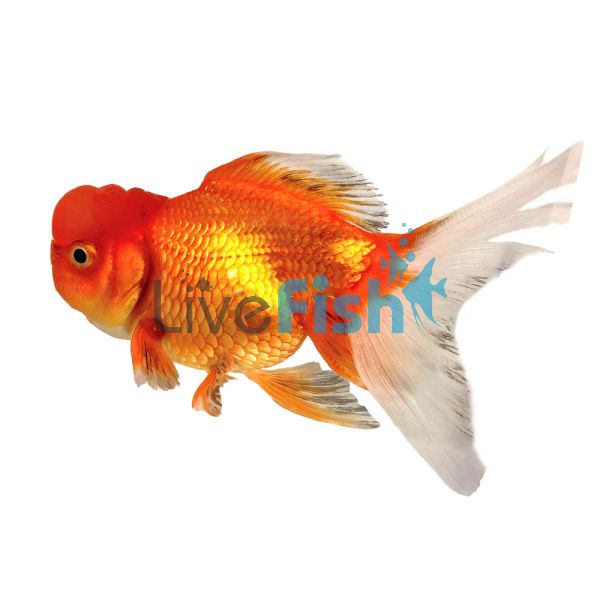Crown Head Oranda 12cm
Oranda Goldfish would have to be one of the most popular strains of fancy goldfish, their endless colours, comical look, and elegant fins make them a fish that aquarists will often dedicate their entire hobby to keep. Crown Head Orandas are a further selective bred strain that isolated the bubbly that went to the top of the head to create a crown-style effect. Whilst Orandas can be as cheap as a few dollars as juveniles, it’s often very hard to know what they will look like when adults, the true fin structure, colours and body shape is something that changes very frequently through the early stages of the fish’s life. Since these fish are 12 cm and almost fully grown the colours and body shape are almost completely mature.
- Buy 2 for $91.68 each and save 10%
- Buy 4 for $81.50 each and save 20%
Crown Head Oranda 12cm
Oranda Goldfish would have to be one of the most popular strains of fancy goldfish, their endless colours, comical look, and elegant fins make them a fish that aquarists will often dedicate their entire hobby to keep. Crown Head Orandas are a further selective bred strain that isolated the bubbly that went to the top of the head to create a crown-style effect. Whilst Orandas can be as cheap as a few dollars as juveniles, it’s often very hard to know what they will look like when adults, the true fin structure, colours and body shape is something that changes very frequently through the early stages of the fish’s life. Since these fish are 12 cm and almost fully grown the colours and body shape are almost completely mature.
These Crown Head Orandas are large fish that have essentially reached full adulthood which means that the colours and body shape they have will have little to no change for the rest of their lifespan. Orandas, in general, are quite spherical fish with a curved back and large fins. These crown heads are bred to have a localized growth of bubble-like skin called the wen around the top of the head. In regard to colours, this is something that varies greatly in orandas, they can range from solid colours such as white or red to a complete mix of colours. It really comes down to the individual lineage of the fish which is what makes them such a popular fish for breeders who like to play with colours present in the fish.
Breeding these fish in captivity is possible and quite easy, especially with fully grown fish like these. Sexing these goldfish is possible but can be difficult without seeing behavioural signs however females will tend to appear to be larger when filled with eggs and have clear cheeks plates whereas males tend to develop star shaped bumps. Males will chase the females and entice them to scatter eggs which males will fertilise. The goldfish exhibit no parental care so it is best to take the parents out once the eggs have been laid.
Tank Recommendations for your Crown Head Oranda
These Oranda Goldfish can get fairly big at 20 cm both in length and height meaning that an individual fish would need a minimum volume of 120 litres. A larger aquarium is always better because what is better than one personable and adorable Crown Head Oranda goldfish? Two Crown Head Oranda goldfish of course!
The thing to note with Oranda Goldfish is that, due to their compact body and flowing fins, they are actually not the best swimmers, so a slower flow is better. A sand substrate is good as these fish will sift through the substrate in search of food however, they can thrive in a bare-bottom system. Smooth river stones can be added for further decoration however sharp materials should be avoided in the aquarium as these large Crown Head Oranda can easily get injured by them.
Suitable Tank Buddies
Crown Head Oranda Goldfish are great fish as they are not aggressive in the slightest and can be kept with a range of tank mates. The goldfish however might eat fry produced by other smaller fish however they will be perfectly fine with adults. Fin-nipping species should be avoided entirely as they will make short work of the slow-moving goldfish.
Usually Compatible
Medaka Icefish, Paradise Fish, Giant Danios, Zebra Danio, White Cloud Mountain Minnows
Sometimes Compatible
Species can be fin nippers like Rosy Barbs and tropical species such as Angelfish, Dwarf Cichlids, Mollies, and species of a similar sort.
Rarely Compatible
Larger cichlids and fish that have a mouth large such as the Oscars, Jaguar Cichlids, and Shrimp should also be avoided as these large oranda goldfish would eat shrimp in an instant.
Feeding your Crown Head Oranda
Feeding Oranda Goldfish should be a breeze, they should immediately take to any aquarium food practically within 24 hours of being added to their new home. Having other goldfish as well will really boost their confidence during feeding time. Slow-sinking foods would be best as these rounder strains have been known to at times get swim bladder issues after frantically gulping for food at the surface. Good quality pellets or flakes that are rich in algae or spirulina content are best to suit their herbivorous diet. Feeding some natural colour enhancers will also seriously make these fish shimmer
| Scientific Name | Carassius Auratus |
|---|---|
| Care Level | Easy |
| Common Names | Oranda Goldfish, Crown Head Oranda |
| Diet | Herbivore |
| Fish Family | Cyprinidae |
| Lifespan (years) | 15 |
| Max. Length (cm) | 15 |
| Min. Tank Volume (l) | 120 |
| Origin | Asia |
| Reef Safe | No |
| Sociability | Peaceful |
| Venomous | No |
| Water Conditions | 22 - 26° C, pH 7.0 - 8.5 |




